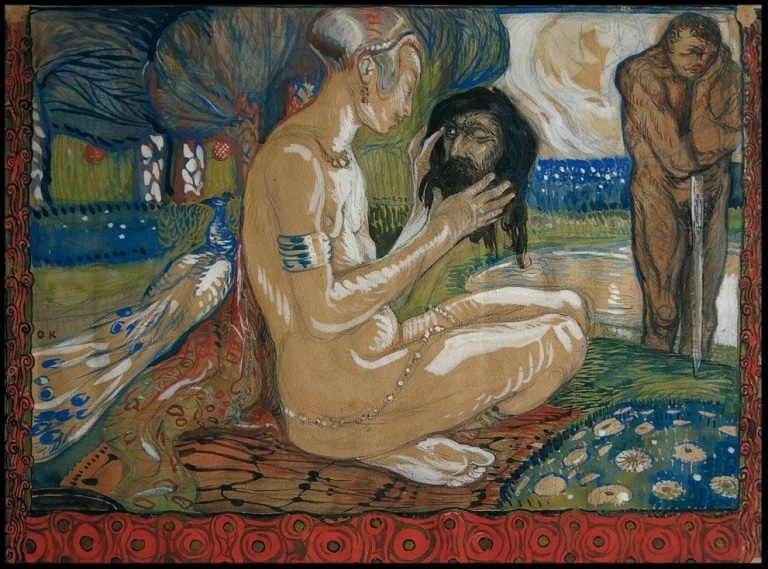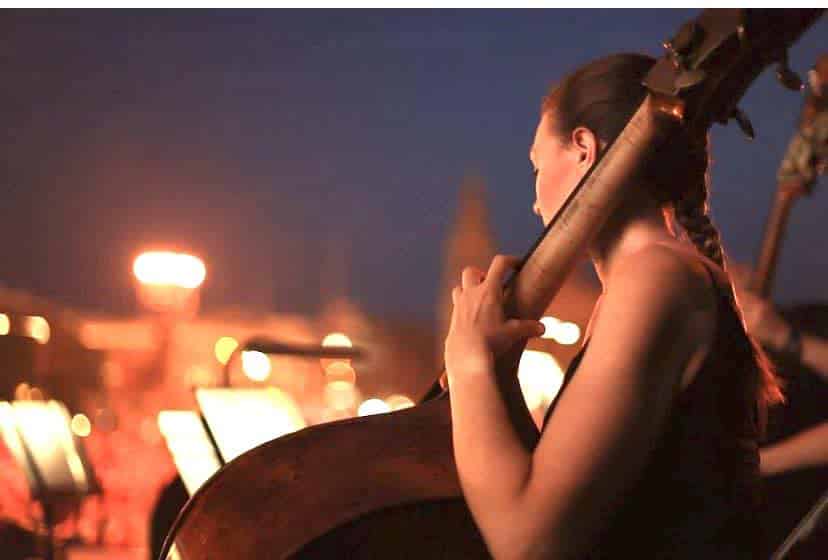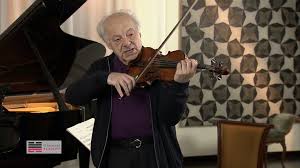Salome: Your favourite picture?
mainBasia Jowaorski reminds us that Richard Strauss’s opera was premiered 115 years ago today. She also supplies an image we’ve never seen before, a sweet girl playing before bedtime with the decapitated head of John the Bapstist.

Turns out it’s a Kokoschka, dated 1906, before the artist met Alma Mahler.
Gustav Mahler in 1906 was doing all he could to get Salome past the censors at the Vienna Opera. He failed.
Richard Strass was not grateful.
So it goes.
Some other memorable Salome images? Maria Ewing stripping to the buff at Covent Garden in 1984 and Karita Mattila at the Met 20 years later. Both images have been censored off the internet.
Plus ca change.





This is a well-known Kokoschka image, well, for art historians, at least….
The internet has gone nuts. One gets easily three days “Facebook-jail” for sharing a nude Modigliani, thus breaking the community rules showing “nudity”. Imagine then showing a “beefy” Rubens, or worse, a naked 16 year old girl with a decapitated head (!)
We are witnessing the total anti-evolution of Mankind.
Wait, “Mankind” – is that manchauvinistic now?…
“Itkind” is better.
“We are witnessing the total anti-evolution of Mankind.”
Devo called it way back in the 70s.
Thank you Norman!
Speaking about Salome in the buff, I could be wrong but I believe Catherine Malfitano also had the courage to do the same.
I was there the night Ewing hit, accidentally, the “silver” salver carrying Samson’s head. For some benighted reason stage management had decorated the edge of the tray with alternating parsley and green Golden Delicious apples. One rolled off and the super just managed to save the rest. It was before there was a net in the pit. I was sitting on the front row, audience right. The apple rolled down the stage hit the neck of a bass then it’s players head, ricocheted off on to a cymbal then a drum. We in the front row were in hysterics, trying to muffle our laughter and the whole row of seats was shaking as we watched in horrified fascination. Needless to say, the conductor ?Colin Davies did not know what had happened but knew something was up and was glaring round at us which made it worse!
Liz, there’s no Samson in Salome. It’s John the Baptist. A prophet from the New Testament. Samson appeas in the Old.
Oh yeah of course how silly of me apologies.
Sometimes, when Samson has enough of Delilah, he walks over into the other biblical opera and sings Jochanaan’s part from the dungeon when the baptist has to answer a physical need. And when the more recent prophet has indigestion, it sometimes so happens that it’s Samson’s head landing on the silver plate, with chopped hair.
Hi Elizabeth,
The same thing happened to me ages ago when I was the pit drummer in a production of West Side Story!
In the last scene, after Maria takes the gun that Chino just shot Tony with, she cries out with grief and throws the gun away. But one night in our production, she threw it so hard that it skittered across the stage, OFF the stage, and bounced off my suspended cymbal and then onto my floor tom-tom before finally hitting the floor of the pit! It happened so fast I couldn’t do anything to stop it.
Needless to say, when the audience broke out in laughter, the tragic mood of the scene was, shall we say, compromised.
Thank you for reminding me of an incident I hadn’t thought about in years!
– best regards, Greg
“Censored off the internet” ? Hardly ! https://youtu.be/wFcoz20dsTk
Have to sign in to see this. Age consent and all that.
I didn’t. Where on earth do you live, or is your computer child-protected in some way?
That’s incredible!
There is a yuuuge difference in build between Ewing and Mattila – one is a mozartean lightweight and the other is a wagnerian heavyweight.
Mahler may have failed on the censoring front but he showed up for the Austrian premiere, as did Berg and Puccini.
Peter Hall’s luminous Salome with his wife Maria Ewing premiered in 1986 in Los Angeles and reached London two years later, where it was filmed in 1992.
The story goes that after the curtain fall of the public dress rehearsal, with a bewildered audience in shocked silence and in disbelief of what they just heard and saw, Richard Strauss, who was sitting in the first row, got up, looked at the folks and said in his Bavarian accent: “Also i kann ma net helf’n, mir hat’s g’falln” (Anyway, I can’t help it, I liked it).
Great story.
There’s another one about a rehearsel of Elektra when the conductor – not Strauss this time although he was present – looked around being irritated about a cleaning-lady who was shuffling somewhere in the back of the stalls, and asked agitated: ‘What’s that woman doing there?’ upon which Strauss dryly answered: ‘She’s looking for a triad’.
My favourite images of Salome start with Aubrey Beardsley’s 1893 illustrations and John Vassos’ 1927 book of “conceptions” to accompany his edition of Wilde’s play (he also did “The Harlot’s House” and “The Ballad of Reading Gaol”).
As for moving pictures, I can’t imagine anything better than Alla Nazimova’s 1923 film (a superb DVD restoration offers a variety of musical soundtracks). Obviously it is strongly influenced by Beardsley. If you’ve never seen it, please track it down!
Caravaggio, “Salome with the Head of John the Baptist.”
Or B. Kliban’s cartoon “The Head of John the Baptist with a side order of fries”
One of my favorite operas. The libretto is filthy and the work is not too long.
Yes. And the music is just as filthy, haha.
Interestingly, it is the only Strauss opera where the kitsch and the vulgarity of the music does not irritate because they correctly express the plot.
The virtuosity and morbid intensity of the music overcame even the barriers of sophisticated taste in early 20C France: Debussy and Ravel both liked the opera.
However much I admire the score, sitting through a production with mostly exaggerated tastelessness is an ordeal.
“Interestingly, it is the only Strauss opera where the kitsch and the vulgarity of the music does not irritate me because they correctly express the plot.”
I called the European Composers Union in advance to ask whether I got permission to react to a [redacted] comment on this site, so there we go:
The presence of kitsch and vulgarity in Salome’s plot is not a matter of subjective taste but clear to see for anybody with a minimum of insight.
The kitschy and vulgar elements in the music of Salome are clearly audible for any listener with a minimum of musical experience.
The connection between the two is obvious to any person with a minimum of intelligence.
The kitschy and vulgar passages may cover only some 30% of the music, the rest is the product of an incredible musical imagination in handling the orchestra – which was acknowledged by all Strauss’ serious collegues. I’m sure Mahler was appalled by subject and plot but thought the music is so spectacular that it overrules any objection and he was right.
It must be said that the complexities of the score cause inevitable vagueness in terms of performance: when you follow a recording with the score, players are often just not in time and textures give a more general impression than a correct rendering, and the same with the singers who have to recreate very difficult parts. But Strauss knew this, and called such writing ‘al fresco’ – giving a quick general impression, not a clear sound picture.
Small point, maybe interesting or not: in the Oscar Wilde play, he never specifies that Salome gets naked. It only says, in the form of stage direction, “Salome dances the dance of the seven veils.”
It IS interesting though. And a more distasteful moment in an otherwise average distasteful plot. The dance almost always falls flat in productions, it is too silly in realisation, with the silly music underneath.
I saw the Mattila performance at the Met. She is a trained dancer, and it shows. Her dance *before* the half second (or so) of nudity was the most sensual thing I have ever seen on the opera stage. And while she was dancing I thought: this dance is so suggestive that it *must* end with full nudity, or else it doesn’t make sense. And it did end with this split second. This was the *only* time in my entire opera life that I felt that nudity was absolutely necessary for artistic reasons… Later, they cut that half second from the DVD. A disgusting lack not of courage, but of artistic integrity.
How ‘real’ should opera be? Cutting the head of the baritone for real will violate union rules, the love scene in Tristan would invoke police intervention, the end of Goetterdaemmerung would burn down the house, and the soprano’s murder in Carmen mobilize the feminist defence storm troupers. Better to stimulate the audience’s imagination instead.
You are so right. I remember workshopping Titus Andronicus in a graduate drama directing course. The leader assigned two versions of Lavinia returning after her rape and mutilation — one all bloody and gory and as noisy as a mute could be, the other silent and destroyed. No two ways about which was the more effective.
And I recall being with a couple of lads when a picture of Marilyn Monroe, in that famous image from a movie with her dress being blown up by a subway passing below a grating — suggestive but not revealing — saying they found that more sexy than nudes splayed out in Playboy.
Audiences are active participants in art, even when they are sitting in silence.
Very true!
The same with reading literature, or poetry.
There is poetry that is, on a rational level, entirely incomprehensible and yet profoundly stirring.
And there is music which is deeply moving without any indication ‘about what’ it actually is, or what it wants to ‘say’.
These days you could not even show the “segreto” in “Il segreto di Susanna.” Not if children are present!
Herod was the first critci of “Salome”, getting in his last line “Kill that woman” just before Richard Strauss’s good-natured comment from the first row in Bavarian dislect. Good to see mention of Aubrey Beardsley, Oskar Kokoschka, and Oscar Wilde, who wrote his play in French.
That’s a wonderful tale, Greg Bottini, of your “West Side Story” percussion malfunction. If Shostakovich had written it, he would instantly have said, “Leave that in” and amended his score.
Vengeful stage-hands once nailed down a fan lying on the stage, waiting for the diva to snatch it up and furiously extinguish herself. She was still struggling with it as the curtain fell, like a hapless Siegmund tugging vainly at the sword Nothung stuck in the World-Ash tree in “Walkuere” while desperately repeating “Now out of thy scabbard leap.” Much nicer is the Marschallin’s fallen bjet retrieved by the sient scampering blackamoor at the end of ‘Rosenkavalier”.
The largest falling object I’ve seen on stage was Josef Greindl’s invincible giant Fafnir, who stumbled on his parabola in “Rheingold” at Bayreuth and almost rolled off into the Mysterious Depths,as players ran for cover. He stopped just short of the foot-lamps while Keilberth and Hans Hotter tried to keep straight faces.
A production of “Salome” that used a Viennese critic’s head on the salver is too familiar to mention. I can’t agree with John about Salome’s dance music,a marvelous amalgam of faux orientalism and Viennese horns, one of Karajan’s best records, and before him Artur Rodzinski’s.
When Strauss played Salome to Mahler and his wife, he had not as yet written the dance and said: ‘O, I’ll just write something quickly and insert it later-on’. Alma later commented that when she heard the work live, she felt the dance did not quite fit into the fabric and I think on this occasion she was right. It sounds like a cheap thing from a world exhibition entertainment of those days.
Here it is:
https://www.dailymotion.com/video/x72clm9
Brilliant kitsch, but kitsch nonetheless.